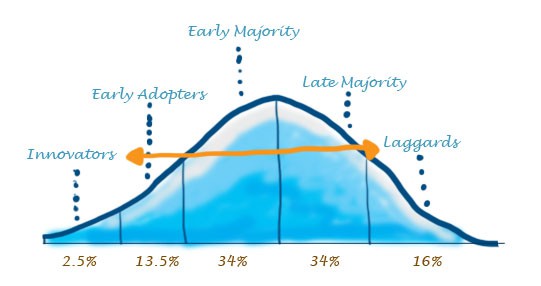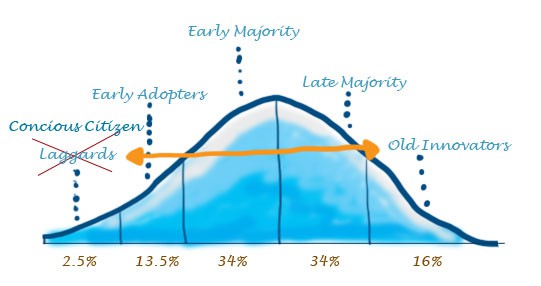Time to Rethink the Bell Curve?
As a product designer I’ve always struggled in my mind with innovation and the appreciation of the amazing new designs and technology constantly released. alongside the amount of stuff this creates. Their tantalising promises to create ease and simplify life, promising to speed up how fast we can find and get to places, and their ability to add a higher quality and definition to our lifestyles. I can marvel at their beauty, the creativity and Ingenuity, but, when it comes to the crunch and when I start to query if I really need it or could I do without, just make do with what I’ve got…. The answer most often is yes. The months and years will pass, my life will continue and meanwhile the technology will quickly move on to the next. Alongside this there have proven to be lots of alternatives and benefits to this response, environmentally, socially and financially (but that’s probably a whole other story).
So where then do I, and what seem to be growing numbers, fit with the Rogers recognized Bell Curve or Diffusion of Innovations, the world of adoption of innovation, of buying and using innovative (usually technology) products?

This model would indicate that the first smaller group of people to take up or try a new product are the “innovators,” followed by the “early adopters.” Then the “early and late majority” follow, until the laggards finally succumb and begin using it. Laggard is a term defined as a person or thing that lags behind, makes slow progress and falls behind……..nice.
So looking at this I guess I would be classed as in with the late majority, or a laggard. I only changed reluctantly to a smart phone about two years ago after moving to London (beginning tweeting and grappling with public transport options…) and am writing on a laptop now 4 years old and that’s about as far as my “gadgets” go.
Is this really the case, am I and others really laggards of innovation?
How does this thinking and classification fit however when considering the world of sustainability and eco-innovation, of social and system design and a need to move towards less consumption-based lifestyles? How does this work when we look through the lens of waste prevention? Are we all laggards because we don’t want to buy lots of new things and love our stuff for as long as we can?
Should the innovators, now so often associated as a word to portray the introduction of something supposedly better than before and in many cases a technology, still be seen as the leaders and those to aspire to? When, in fact one of the consequences of this is that they often end up consuming more, the ones that are quick to discard and replace their old technology when the new version comes out every 6 months. Meanwhile the “laggards” are choosing to hold off from buying it in the first place and the late majority makes do for longer until they can’t avoid the growing system around them. We are almost forced to upgrade or renew to feel connected to society or as manufactures push us on to the next with short life times, a lack of replacement parts or maintenance possibilities.

Perhaps though the “laggards” are beginning to find themselves in a new position as the “new innovators”. Those that are consciously choosing a different role and lifestyle, keeping and adopting or re-adopting new or old ways of consuming or just continuing with ( staygrading ) less consumptive ways of living not reliant on buying the latest technology.**
I came across similar thinking recently at a Cleanweb talk on sharing, reuse and recycling where Mark Shayler from Green Ape also put these thoughts out along the lines of – It’s hip now to have a Nokia 3220 – almost a reverse snobbery – (or something along those lines). Is it becoming more cool (although I’m not a huge fan of that word) not to consume new and often? Encouragingly for many “cool” is not the aim but simply a naturally informed choice to make as a conscious citizen.
In the UK we are seeing a wealth of “innovative” start-ups, organisations and charities that could be perceived or assumed in former years to be working in the traditionally perceived ‘laggards’ region (no offence), embracing reuse and recycling, fixing and mending, encouraging sharing skills and products rather than ownership. The ReStarts, the Streetbanks, the charity shop reuse models, the grow your owns. These as well as serving a real need and purpose, also add additional value through their more hands on approach and connectedness to others, the real value of materials and the consideration of nature. Technology becomes less of the focus but purely a platform or shared enabler, not the desired product or result.
The New Citizen Project also recently exemplified this observation, wanting to open up the conversation “about spotting, celebrating and debating where the shift from Consumer to Citizen is happening already” and earlier in the year Keep Britain Tidy as well in their No time to Waste positioning paper – Design for Life – called for “consumers need to be encouraged and allowed to reclaim their role, firstly as citizens, or members of the community. They should feel empowered and motivated to take part in a movement to a society that is mindful of the impact of its lifestyle on other people and the planet”
These are the forward thinkers who are embracing practices, products and activities that look much, much further into the future and challenge the norm of traditional technology driven innovation or business models pushing us towards consumptive lifestyles. The rise of the reverse adopters that drive for more sustainable innovation for society and the planet.

We need to flip our thinking and perceptions of the innovative, the cool and the consumer and aspire to and embrace the un-consumers, the reverse adopters, the conscious citizen, and let them thrive.
**There are of course exceptions to this where when we look towards technology related to areas such as energy efficiency, or renewable energy methods, those installing solar panels on their roofs or investing in community wind energy schemes. Here technology and the innovators or early adopters are investing in this to support a more sustainable way of life (as well as self-sufficiency and money savings).


Pingback: Stepback and Smile | TechnicalNature